Do you need pectin to make jam? I used to think so.
I followed the recipe on the inside of the pectin box slavishly for 7 years before I broke free of the pectin bonds. Every year, my strawberry jam tasted exactly like the strawberry jam of everyone else who wore the Sure-Jell shackles. The jam was never bad, but it was never really mine, either.
Before, jam making was about following rigorous and strict recipes, adding in a ton of sugar to “ensure a good set,” skimming diligently to remove foam and crossing my fingers while timing that one minute of “hard rolling boil” down to the second. That’s what was required by the pectin box master and I was terrified to change a thing lest I ruin an entire batch of jam.
Now, I’m a liberated pectin-free jam maker, and I’d never go back.
When I make preserves now, I work with my fruit, tasting and adjusting things like sugar and spice based on fruit ripeness and variety and juiciness and what sounds good. I reduce water out of my preserves to get the consistency and depth of flavor I’m looking for. I reduce sugar levels down to one-forth or less of typical levels and still produce a preserve that is full of sweetness and sunshine. My jams, each and every batch, are creative and unique.
The only things I slavishly adhere to now are sanitation and processing standards, and acidity levels, which ensures that while I’m having fun and getting to be creative jam-girl, I’m also producing a product that is faultlessly and impeccably safe for my family and friends to enjoy.
Here’s how I make high-acid fruit preserves. All photos in this series are from a batch of Apricot Jam with Lime, Ginger and Tequila that turned out so good I said, “Sweet baby Jesus!” upon tasting it. Except I pronounced it “Jesús” in the Spanish way. You know, in honor of the tequila.
As I mentioned in yesterday’s post, I think of the flavorants I add to my preserves as either “Dry Zing” or “Wet Zing” because they add that zing of flavor I’m looking for and they are either dry (herbs and spices) or wet (boozes, extracts, vinegars, etc.). If you missed it yesterday, you can download a Flavor Maker Chart of Wet and Dry Zing suggestions for all the fruits I typically jam on the Downloadables page.
Basic Pectin Free Preserve Formula
makes about 4 half-pint jars of preserve
- 2 pounds washed and appropriately prepared fruit (Peel, seed, chop, etc. Weigh after preparing.)
- 4 to 8 oz (a gently rounded ½ to 1 cup) organic sugar
- 1 tablespoon freshly squeezed lemon or lime juice
- ¼ teaspoon Dry Zing (optional, see Flavor Maker Chart for suggestions)
- 1 tablespoon Wet Zing (optional, see Flavor Maker Chart for suggestions)
Method
For every 2 pounds of prepared fruit, add 4 oz. sugar (a gently rounded half-cup is 4 oz.) and combine in a large bowl. Scale as necessary; I usually do 6 pounds fruit and 12 oz. sugar, which gets me about 10-12 half-pint jars of jam, depending on how much I reduce the jam. Cover fruit-sugar mixture and transfer to the refrigerator to macerate. Let sit overnight, or up to 24 hours.
In truth, I’ve left my sugared fruit for a few days in the fridge and there’s never been any harm done. That’s another reason I like this method. Sometimes it’s very nice to be able to put fruit “on pause” for a day or two until you can get it in a jar.
After 12-24 hours, the sugar should be mostly dissolved and the fruit should have released quite a bit of juice.
Prepare jars and lids as for standard water bath canning. Keep spotlessly clean half-pint or pint jars warm in a large pot of simmering water. Have new lids and clean bands ready. Have a clean lint-free towel or paper towel available to wipe jars. If you are new to water bath canning, I recommend you read this to get a feel for the basic procedures and precautions you must take to ensure you are creating a safe product.
Transfer the fruit, sugar and all the juices to a large, very wide, shallow pan. Something like a huge saute pan is good. You want as much surface area of the preserve exposed as possible to allow for the fastest evaporation of excess water from the preserve. If you have more fruit than you have pan, divide your fruit and juice as evenly as possible among pans, or work in batches.
Bring the macerated fruit and juices to a simmer over medium heat. Stir frequently, you do not want your fruit to scorch.
When your fruit has softened but not fallen apart, add in your lemon or lime juice, 1 tablespoon for every 2 pounds of fruit initially prepared.
Also add in your Dry Zing component, if using. Use ¼ teaspoon for each initial 2 pounds prepared fruit unless you are using a really potent spice like cloves. Then use less. Stir.
At this point you have to decide what kind of texture you want your preserve to have. If the texture in the pan is too chunky or the pieces are too large, crush your fruit with a potato masher or puree as desired with an immersion blender. I like a quite chunky texture but this is entirely personal.
Take a small spoon of preserve, including some fruit and a bit of syrup together if your preserve is chunky, and taste them. Is your jam sweet enough? Does it need more sugar?
If your preserve is tart at this point, add a bit more sugar, up to an additional 4 oz. (another rounded ½ cup) for every 2 pounds of fruit initially prepared. You may need even more sugar if you are cooking something quite tart, like quince, currants or gooseberries. Trust your judgement. If you think the preserve needs more sugar, add it. If it is sweet enough to your taste, leave it alone. Remember that as you cook the preserve longer the flavors, including the sugar, will taste more concentrated. Stir everything gently but consistently.

When your preserve is glossy, a bit darkened and looks slightly thickened, transfer a bit of jam to a cool (ideally refrigerated) plate. If you run your finger through a dollop of jam on a cool plate and the finger mark remains visible or runs together only very slowly, the jam has reached the soft spoonable stage I prefer.
At this point, add the Wet Zing flavoring if desired, using 1 tablespoon for every 2 pounds of fruit initially prepared. If using a flavor extract, like vanilla or almond, use only 1 teaspoon and adjust to taste. Strength of extracts varies considerably by brand and you don’t want to overdo it. Most of the Wet Zing components have flavor compounds that are quite volatile and should be added towards the end of the cooking time lest their flavor evaporate away.
Stir well, taste jam one last time (clean spoon, please!) and make any final adjustments to the sugar level. You may also add additional citrus juice at this point, if desired. If a preserve tastes like it just needs a little something, usually that something is a few drops of lemon juice. No kidding.
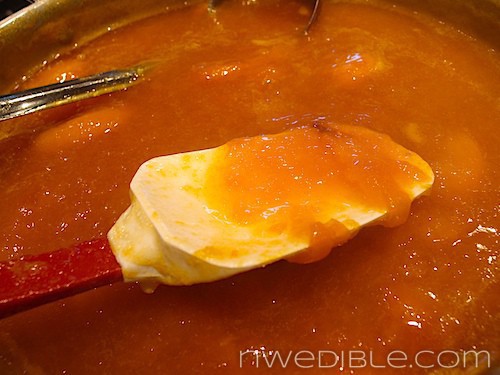
At this point, keep your preserve at a bare simmer and proceed to fill and lid your jars as per standard water bath canning procedure. Remember to wipe the rims of your jars before setting lids! Process half-pint or pint jars of jam for 10 minutes at a full rolling boil.
A word about texture: a jam made in this pectin-free manner will not give you the firm, high mounded spoon look of a pectin jam. The thickness does not come from gelling the moisture in the preserve, but from reducing excess water out of it (this is why using a wide, shallow pan is so important).
Preserves made this way will give you a French-style, soft jam, thicker than syrup or ice cream topping but not so thick as to allow a spoon to stand upright in the jar, as is the case with many pectin-set jams. I find this texture to be more sophisticated, frankly. The depth of flavor and slightly caramelized tones that come from lower water content, longer cooking and reduced sugar content can’t be beat.
And because you are liberated from the chains of the pectin recipe you can have some fun with creating flavors all your own. The only caveat is that your jam, to stay safely water bath can-able, must stay high-acid, with a ph of 4.6 or less.
Have you made pectin-free jam or are you dedicated to the box?
175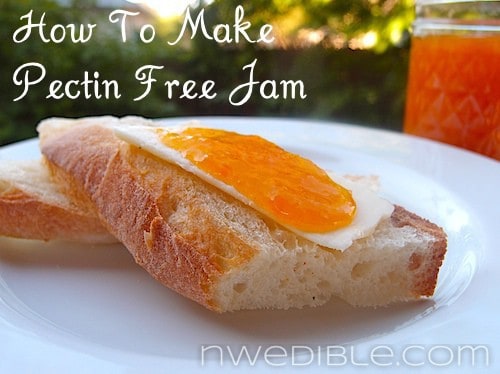
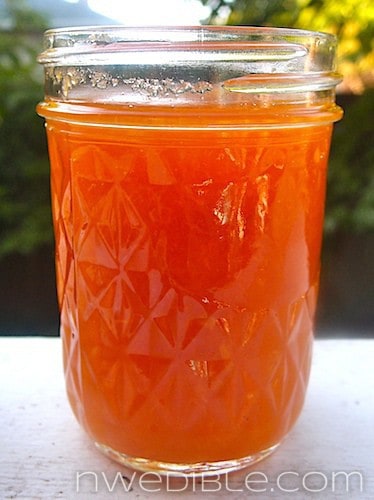
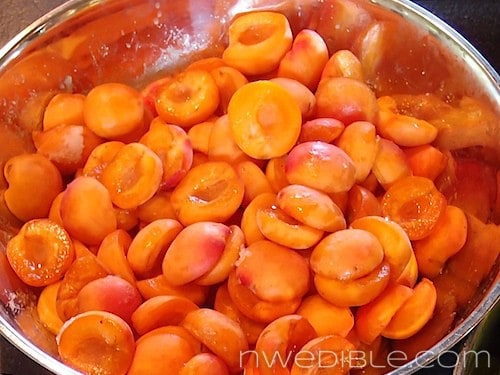
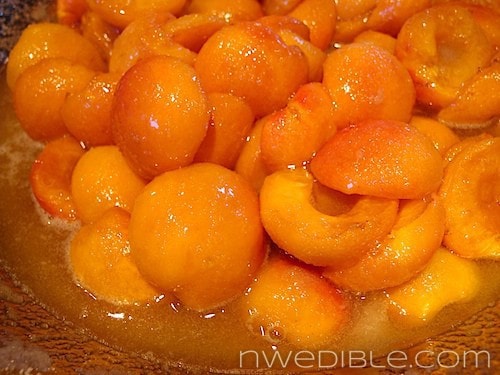
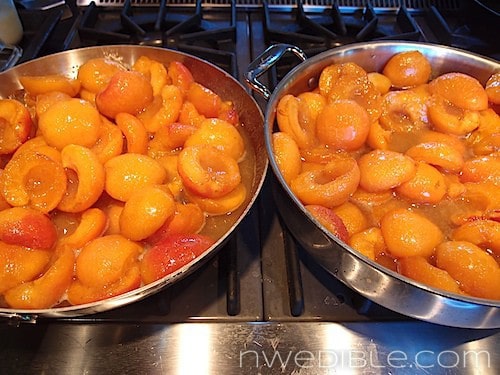
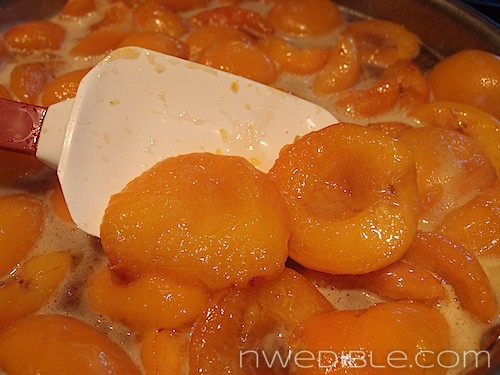
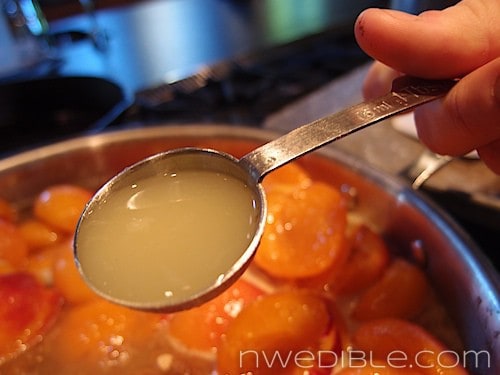
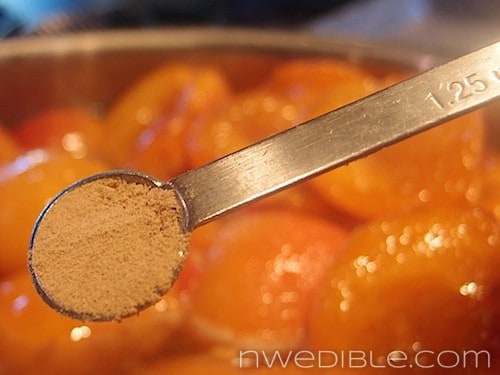
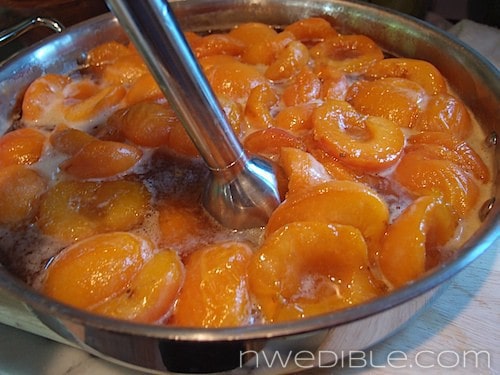
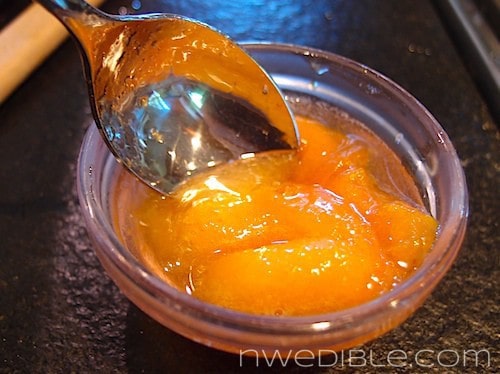
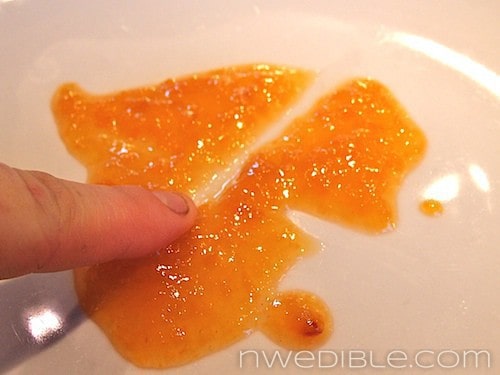
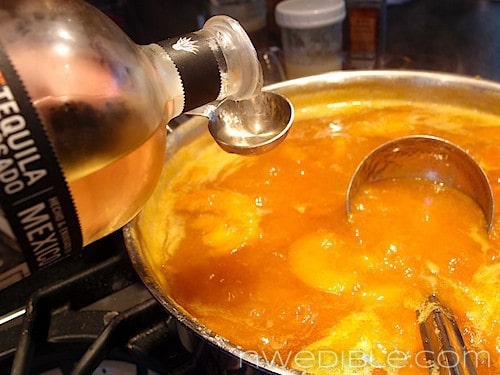
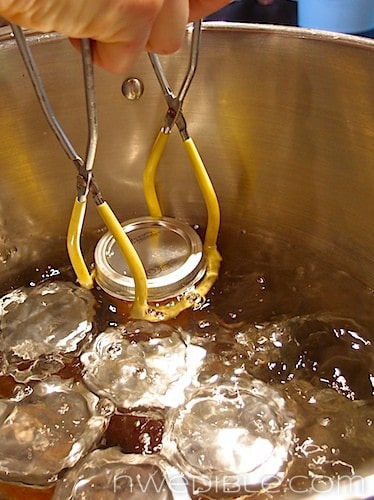
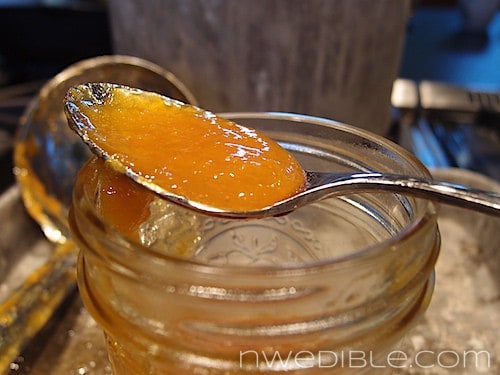


Hello All,
I am toying with the idea of making Blackberry jam using frozen blackberries. I have never made jam with frozen fruit so I’d love to hear any stories or help you can give me about this process. Blackberries are available in my market but they are very expensive. Frozen for the same amount is much less expensive. I’m not totally new to making jam, been doing in for several months now with good results. I was thilled to find this site. It gives me permission to use less sugar. I was never a fan of using pectin. I love the all natural yummy smooth as silk jam. I hope someone will give me some pointer about frozen fruit jam. Also, those who have made blackberry jam, do you strain it to get rid of some of the seeds? Just wondering. Thank you in advance.
Just stumbled across your blog while I was looking for and answer to a question about pectin. I am a Canadian but live in rural Kenya now. Preserving jars are all but impossible to find here so I make my jam in small batches and use glass coffee jars (which I then store in the fridge, hence the small batches). Mango is one of my favorite jams to make and depending on what is in season or available, I also add one or more of plums, pears or pineapple. I am about to embark on marmalade making.
While I was at home in Canada this past summer, I stayed with a friend and on the day before I left to come back to Kenya, I discovered I had an assortment of fruit which had to be used so I made her a big jar of strawberry/raspberry/nectarine jam which she absolutely loved.
Mary,
I started my canning with an old Italian lady who never ever used preserving jars. She just used old jars that she had around the house and heavens even the crappy old lids were used again and again year after year. Add to that she never even used the water bath of sealing the jars. She only made sure they were super clean (boiling the jar and lid can ensure this) and filled them with hot jams. When they were cooled she stuck them in her dark basement… sometimes for years! I ate her jams for a very long time and I remember her telling me if I opened one and there was mold on the inside to just throw it out…. she said that happens sometimes. I never got one of those and the jam never killed me… so I think, if you have somewhere cool to store, which should be an option in the Kenya highlands, then I would go for it. At least you can make more than your usual small batch. Just make sure the old lids do still have some rubber inside them and are not too damaged or bent. Good luck! Kris
Thanks Kris for your super fast reply. I do use a hot water bath for the jars and the covers so I am confident they are sterile. I have introduced my homemade jam to some friends and explained how to make it. Processed foods are expensive here and I am glad to share with the local women how they can affordably treat their families to a jam with bre aking the food budget. Keep Jammin”
This recipes sounds great! I can’t wait to try it along with some of the ideas you present here. I have started using natural pectin from crab apples in my jellies with good results. It try to find large crabapple to wash, cut in half, cover with water in a large stock pot. Then bring to a boil and simmer until the fruit is soft. Then strain out the fruit and keep the juice which is rich with natural pectin. It takes some practice to make good jams and jellies with it but has been a great alternative to boxed pectins.
Hi!
I made this recipe with peaches and raspberries. I processed the jars in a water bath for way longer than you recommend- will this damage my end product? (it was my first time canning, and somehow I missed the 10 minute time limit and decided to do 20)
Thanks!
Jess
PS- it’s REALLY yummy. 🙂
In the blog post that directed me here (which I am extremely thankful for, btw… love the post!), she added green apple to her peaches as she was cooking them to help thicken, then removed them before mashing them. Is that necessary? Are there other fruits that require this step? I am a total jam/jelly noob!
This recipe sounds delicious! I was wondering could the water bath processing be eliminated and turn the jam into a “freezer jam” instead? Thanks!
Erica, I just followed your process and made two batches of peach jam (two-two pound batches), one without wet zing and the other with vanilla and only having tasted the leftovers too little of which to can, this in a shallow pan, only 1/2 cup sugar per 2lbs, it tastes FABULOUS!
It’s almost more like stewed, fresh peaches probably because it has so little sugar. I only let the mixture high simmer, no rolling boil, no need for it. Yes, the yield is lower but I think better quality.
The added benefit was the lower stress level I felt due to simmering the mixture as opposed to “scary” boiling. Oh yeah and I couldn’t get to the jam making for three days after having prepped the fruit and left it in the fridge. A very flexible, low stress, low sugar, delicious jam.
Thank you!
Anna, another cook from Canada
i have been using this method all summer long with my fruit csa from collins family orchards (so awesome!) — it’s been really liberating ! thank you so much for laying it down. i work at the farmers’ market and tell all the people about no-pectin , reduced sugar canning. it’s the best !
Refrigerator grape jam? Help
Hi, I am new to jam making. So far I have made low sugar pectin raspberry jam and it work out quite well but I am not sure if I like the way it’s set but it taste pretty good. A bit too jelly like.
So I decided to make a peach jelly using a recipe with liquid pectin but I decided to put less sugar and I ended up with a jelly that did not quite set. It is like a very, very thick syrup. So I don’t know what to do with it. Should I try to reprocess it and add the full sugar amount? It is so sweet as it is.
I still have a lot of peaches left so I will try to make jam without pectin. My childhood jam were always on the runny side anyway. maybe I should freeze as I wouldn’t know about the whole PH thing. Anyway, out to the store to buy more jars. Thank you!
I am a veteran lemon and kumquat marmalade maker but now have a ton of rhubarb in the garden and am thinking of jam. Do you know if it has a high enough acid content to just go ahead and not worry about? It certainly is tart, but I don’t know if that is an indicator of acidity.
I have been very successful with making Rhubarb jam with only lemon juice and sugar. For some zing I added a pear and some ginger. Delicious! Give it a try. It’s a soft set and my family loves it. I’ve also made it with orange juice and again with raspberries.
Good luck.
In your final picture of the post with the jam and cracker, is that a wedge of cheese? If it is, what kind? If not, what is it? It looks yummy whatever it is.
I found your site when searching for the science behind natural pectin jellies and jams. I have been making no added pectin raspberry jam for… ever. And added no added pectin apple rosemary jelly to my repertoire several years ago. I started playing with sugar levels pretty seriously last year. The jam is pretty much bullet proof. I find it interesting that my raspberry jam does get quite firm. I started taking the temperature (I usually just do it by sound and sight) and without fail the magic temp is 220 degrees — the same for my apple jelly (which I detail on my here if you are interested (http://jenmenke.com/apple-madness-part-one-ugly-but-useable-apples-recipes/).
What gets my mind in a blur is trying to understand how much the amount of water (in the juice) and the added sugar have on the cooking time and finished product. I have not answered my question yet, but I did immensely enjoy reading your post!
I want to leave my fruit/sugar mixture in the fridge overnight, but I am using pineapple guavas and I am afraid they will get brownish from oxidation. Is it okay to add the lemon juice at this stage?
Thank you SO MUCH for this great tutorial! I just made delicious Strawberry Mojito jam using a ton of lime rind and mint. It’s delicious and will be perfect for the Aussie summer.
It is my first go making jam and although it could have set a bit harder, I’m sure it’s still a little runny, its great and my family will love it as gifts! Thanks!! I can’t wait for round 2!
Emma
What is wet zing and dry zing?
Thanks for another informative site. The place else could I am getting that type of info written in such an ideal approach? I’ve a undertaking that I am simply now working on, and I’ve been on the look out for such info.
I have come back to this post again and again. Last year I made lots of peach preserves using your method – macerating them in honey instead of sugar though. Cardamom Amaretto, Tequila Lime, and Earl Grey were all delightful! I came back again this year to see if the method would work for strawberries too – looks like it will. I can’t wait to try this again this week!
I am still using pectin. Can you reduce the amount of pectin and use as a thickening agent, and not as a jelling agent. What will be the results? – Jerry
Pectins in boxes are not good or bad; they are just a tool that you may or may not choose to use. However, it does help to understand the chemistry behind them a bit. Each method has its own advantages and disadvantages. I’ve written about it here:
http://www.wellroundedmama.blogspot.com/2012/09/canning-pecking-about-pectins.html
High-methoxyl boxed pectins (the traditional ones) require acidity and lots of sugar in order to “set up” (gel) properly. It’s more for gel than safety. These pectin powders don’t last very well season to season, they don’t respond very well to recipe tinkering, and there is often more sugar than fruit so they can be overwhelmingly sweet. However, they are very good for high-gel products like jellies or marmalades. There are rapid-set (for marmalades) and slow-set (for clear jellies) high-methoxyl pectins, so do some research on which type is best for what you are making.
Sure-Jell has a low-methoxyl pectin (pink box) that works very well for lowering sugar yet maintaining an excellent taste. (They have a strawberry freezer jam recipe that is to die for.) However, there’s still quite a bit of sugar in the final product and you can’t double batches or tweak ingredients very easily.
Pomona Pectin is a low-methoxyl pectin that uses calcium water instead to “set up” so you can adjust the amount of sugar without hurting the final results. You do get a lot less final product because there’s less sugar, but you can adjust the recipe’s sweetness to taste and you can use other sweeteners (like honey, agave, artificial sweeteners etc.) if you prefer. You can also double-batch or add in extra flavorings without affecting the gel, and these pectins can be stored year to year without losing effectiveness. These are all big advantages.
However, some people don’t like any boxed pectin. Either they make their own pectin from apples/crabapples/citrus skin, or they learn how to jam without added pectins. Canning without pectin works very well with fruits naturally high in pectin. It’s harder with naturally low-pectin fruits like peaches, as the gelling results are less consistent. Often you end up with a very soft “set” (which some people prefer so that’s fine with them).
To improve the gel factor, many cooks in “olden days” before boxed pectins used the skins/cores of fruits, added a bit of high-pectin fruit (apples, currants, gooseberries, cranberries, quinces etc.), or tried to use more under-ripe fruit (about 1/4 under-ripe to 3/4 ripe) to help increase natural pectin levels. These methods work quite well. However, cooking fruit for quite a while often works too, as long as you are okay with the possibility of a relatively softer set.
The new thing to me in this article was the idea of macerating the fruit in sugar overnight before cooking it. Great idea! The sugar should draw out much of the moisture from the fruit so less cooking is needed to evaporate the moisture. The disadvantage of no-added-pectin jams is that they are often so cooked that a lot of the nutrients are lost and the jam has a very “cooked” taste; macerating the fruit so less cooking is needed should help lessen nutrient loss and help keep a bit more of the intense fresh taste.
There is no one right way to make jam. A lot depends on your preferences. As long as you keep things high-acid, sterile, and use water-bath canning, spoiling is not a huge issue with jams, and you will see if something has gone bad (unlike low-acid foods). Using added pectins is simply another tool to help increase the “set” of a jam for those who like them that way. Understand how they work and you will know which one you want to use.
My pectin preferences depend on the type of jam I am making and its purpose (jam for PBJs needs a bit more “set” than jam for toast). Experiment and see what you like best. Lately, I’ve been enjoying adding “zing” to my recipes too; don’t be afraid to play with the flavors. Cherry Cinnamon Amaretto is divine; so is Blueberry-Lime, Ginger-Apple, and Strawberry-Vanilla. This year I will try adding Balsalmic vinegar and more liquors; thanks for that idea!
Macerating the fruit overnight or longer is new to me this year too. I like it so much I’ll be doing it from now on.
After I “caramelized” some apricot jam last year trying to get it to set properly I asked my parents for The Blue Chair Jam Cookbook for Christmas and have been reading it in anticipation of this year’s jam season. No recipes that I’ve read so far call for pectin. And the fruit is macerated in sugar in the refrigerator anywhere from 12 hours to 72, depending. No water added and the jam is slowly reduced to get it thick.
This year I tried apricot jam again using the directions from The Blue Chair with one exception. I also added the cut up rinds of the lemons I juiced to cook with the jam, then picked them out at the end. It jelled up perfectly. No pectin necessary.
Another thing Blue Chair directs is to turn the heat down periodically as you cook. Something left out of a lot of directions I’ve read elsewhere. I think this is essential to prevent scorching (my problem from last year) as you’re reducing the jam . You also need to continuously stir, but unless you turn down the heat, no amount of stirring can prevent scorching if the heat is still up too high.
Choosing the right pan is important too. I use a wide pan as mentioned in this article. But I think my success this year is the maceration, the adding of the rinds and the turning down of the heat as it cooks.
I arrived at this page looking for flavor additives. I added spices and bourbon to the apricot jam and it is to die for. I’m getting ready to do nectarines and looking for a paring for that. I’m leaning towards using limes, ginger and maybe Amaretto or Bourbon again. This article is just what I need to start experimenting.
I too have freed myself from the strange textures and flavors of preserves made with commercial pectin. However, the fruits we love to use for jams and jellies do contain pectin, naturally. Even apricots and strawberries contain some pectin, although much less than other fruits, such as apples. The neat thing about recipes like the one above, is that we can take advantage of the natural flavor and perfume of the fruit, and use only enough sugar to obtain a product that tastes like that fruit.
I just made a batch of mango jam with cinnamon as the dry zinger and Amaretto as the wet zinger. So good! I love your guide and I feel inspired to play around this summer with different flavourings. My family and friends are probably going to get sick of getting jam as gifts!
Thanks you so much!
I tried this, and must’ve gone wrong somewhere. I was using mulberries, followed the instructions, and it turned into a really thick paste like result… and only made one jar >.< I'm hoping to try it again with a different fruit, and try to see what went wrong.
Beginning the no-pectin process today with strawberry and strawberry-rhubarb. Have you tried substituting xylitol or stevia powder (NOW brand) for sugar using the no-pectin process?
Enjoy your site! Thank you for your time and efforts.
Anne from Wisconin
I just made a batch of apricot jam. For 2 1/2 pounds of fresh apricots, I used about a 1 1/4 cups of sugar. It was BEYOND wonderful!! I am now pectin free! I feel so incredibly liberated, especially because I don’t have to stress about rolling boils and carefully timed rolling boils. I especially LOVE being able to uses far less sugar! Can’t wait to use my bumper blueberry crop on this recipe. Thank you, thank you, THANK YOU!
I am assuming that the need for ph is only when waterbath canning. I am going to use a pressure canner so that I can use less sugar and not have to worry about ph, since it’s what is used for lower ph vegetables.
Thank you so much for this post. I’ve been jamming for years, but always used the boxed Sure-Jell. When our family started cutting out processed foods last year, I stopped using the boxed pectin, but couldn’t find a good jam recipe that I liked. I just made a batch a cinnamon-peach-blueberry using your recipe and it is amazing! I can’t wait to try new flavor combos!
Pectin isn’t a frankenfood. I occasionally use it but am going to attempt making my own just because buying it is so expensive. Pectin comes from the seeds and white pith of lemons. Whenever I juice a lemon I’ll also grate the skin, then put the seeds and white pith in a bag in the freezer. When I have enough, I’ll cook it and make pectin. Then I’ll process it to save it for use later.
Do a google search on making your own pectin and you’ll see how it’s done.
In the meantime, don’t be afraid to use commercial pectin if necessary.
I’d be more inclined to avoid the white C&H highly processed sugar and go toward a natural organic cane sugar for my jam.
I looked into making my own pectin due to the high cost of buying it.
Pectin comes from the seeds and pith of the lemons. So after I grate off the rind to freeze and use later, and squeeze out the lemon juice, I have been saving the seeds and pith (white part of the rind) in the freezer to process later and make pectin. Haven’t gotten there yet.
But what I have been doing with this year’s jam is to squeeze the lemons for their juice, save the seeds, then I cut up the remaining lemon rind and put the in the jam during the cooking. At the very end, I pick them out. I don’t know if having the rind in there cooking is adding any extra pectin but this year I’m not having problems.
I’ve also bought a bottle of pectin so I can adjust how much I add if any. I didn’t need it for the apricot but did for the strawberry. Sometimes it’s only a tablespoon or two in a quarter cup of sugar. (I use no sugar pectin).
Well it’s cherry season and I got really excited about making pectin free jam with the cherries I picked up. I used approximately 8 cups of cherries, 6 cups of sugar and lemon juice. I’m not sure what happened but they never set. Not I’ve got 2 big jars of cherries in syrup. Any suggestions appreciated. 🙂
Ice cream topping. Any failures make excellent ice cream toppings (milkshakes and cherry cola soda drinks too.) Some years my husband will request a batch or two of his favorite fruit “failed” into the thinner fruit syrups.
Wow. I had no idea you could make jam without pectin! Yes! This is so exciting. I totally have to try this. Thank you for the recipe and tutorial!
Thank you for this great lesson. I’ve been heading away from the boxed pectin jams. I’ve also went the Pamona’s Pectin route and was distressed at the rubber cement texture that PP produces. I love the idea of the French method and trying to learn basics from others who have led the way. I recently made my first batch of nectarine pectin free preserves and it was crazy good. (Tried both the spiced and fruit only recipes) and surprisingly loved the “dry zing” of cinnamon and pumpkin pie spices blended with the fruit best. Now I’m more willing to try flavor combinations than in the past. I think purchasing a ph meter is the way I’ll head to ensure food safety. Keep the advice and recipes coming. Thanks again.
Hello Erica, I stumlbed upon your 2012 low sugar, pectin free jam post and loved it. My favorite jam to make is fig jam (sometimes with burbon & sometimes with rosemary). Due to the acid levels, etc in figs, might you be able to tell me the safest way to make my jam low sugar and pectin free?
Thanks SO much!
Just wondering if anyone has tried this method using huckleberries. I’ve used it with strawberries, blueberries, raspberries, apricots and peaches with outstanding results. Then I made two batches with fresh, just-picked huckleberries and ended up with 10 pints of very flavorful syrup (which won’t go to waste, but just won’t cut it as jam). Anyone have any luck with these precious, wonderful little berries?
I just used this method for a batch of Beach Plum jam. I like the idea of French style jam especially since my previous attempts with Beach Plums were way too thick. I will keep you posted as I just finished canning them and I am waiting for the pops!
I noticed that you mentioned if peppers are used in the jam that it would need to be pressure canned. I thought that peppers fell into the same category as tomato in being high acid and okay for water bath canning. For a 2 years now I’ve made a raspberry jalapeno jam and I only followed the regular water bath canning method, no vinegar was used. Should I be worried?
Also, I didn’t see you mention anything about skipping the refined sugar and using honey as a substitute. After seeing several recipes using honey and no sugar I made my jam using organic raw honey. I noticed that my plum jam is a little more tart than before, but I’m not sure if that is due to the honey or due to the fact that the plums weren’t as ripe as they could have been. Do you see any issues with only using honey or agave nectar in a 2/3 to 1 c. ratio in place of sugar?
Hello All,
Someone asked about using honey or agave instead of sugar. I would love to have an answer about that.
Love this site. Thank you so much.
Estelle
Funny that Hero used to make all preserves sans pectin, and they were wonderful! Since they started adding pectin to all their products, they now prepare watery, mildly fruit-flavored mush.
I’ll have to try some of these suggestions.
Hi Erica,
I just found your site when I was looking for low sugar/no pectin jams. To think what I have been missing!
I do have a couple of questions:
1. I keep reading that you can increase the firmness of jam if you put lemon seeds or lemon pith (in a tea ball) and add them throughout the cooking process. Do you know if that is true?
2. I am at 4,800 feet here in Utah. I know I need to add at least 10 minutes to the water bath time. Is there any other advice I need for cooking at a high altitude? I did read some comments here that their jam turned to hard candy at high altitudes.
Thank you for all your help. Can’t wait to make some peach raspberry jam next week.
Dorothy
Banana Peach jam. My mothers, and now my, specialty and I’ve never seen it anywhere else. It is like sunshine on toast.
I was searching Google for new no-pectin jam recipes when I came across this post. My heart is leaping with joy, lol. I’ve got 14-oz of frozen cherries begging for something to be done with them. All the standard recipes I’ve encountered so far are the typical Ball book ones that involve pectin and butt loads of sugar. I’m going to try your method and I couldn’t be more excited!
I prefer everything about the process of making pectin-free jams. It’s amazing to me that others point to how easy pectin jam making is, because that’s how I feel about pectin-free jam! I never get a good set with pectin! It’s always a tense guessing game – Is this the “hard boil”? Should I start timing now, or should I wait until it boils even harder? Will it boil harder? Will it OVER cook? My jams always end up like runny syrup or hard paste. And, as you pointed out, your jam tastes like everybody else’s jam.
I’ve had great luck with old-fashioned jams. They ALWAYS set up, their flavors are richer and more complex, and they look gorgeous. The whole process is much more relaxed and enjoyable, too. I can set up my canner and jars with no running around the kitchen like I’m at a track meet. I’m not on edge about the all-important boil. No guessing involved with the gel tests – what you see is what you get! Not to mention that you can double or half recipes with no drama!
I went ahead and made cherry-blueberry jam using the process here. I got mixed results, which I think I can probably blame on my cherries being overripe and therefore not containing much pectin. As usual I enjoyed skipping the Sure Jell box and doing my (your) own thing.
I’m not sure how to describe the consistency… It never reached gel point, but all the water cooked out and it wound up very chunky. Jam-like chunky, but without the glossy finish. I think maybe I made mashed fruit preserves. I went ahead and processed my two jars (2 lbs, 2 oz only yielded 2 8-oz jars for me!) Nevertheless, it’s thick enough to use as a normal jam and tastes pleasant enough. The brandy gave it a much needed kick. Again, I’m going to blame the quality of my fruit in this instance. I know how kickass pectin-free jam can be! Thanks again for the awesome step-by-step instructions. I think cranberry-pear is next on the agenda… : )